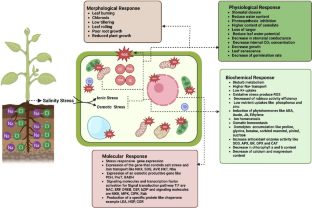Environmental Geochemistry and Health ( IF 4.2 ) Pub Date : 2024-04-05 , DOI: 10.1007/s10653-024-01921-8 Abhishek Singh , Vishnu D. Rajput , Shivani Lalotra , Shreni Agrawal , Karen Ghazaryan , Jagpreet Singh , Tatiana Minkina , Priyadarshani Rajput , Saglara Mandzhieva , Athanasios Alexiou

|
A slight variation in ecological milieu of plants, like drought, heavy metal toxicity, abrupt changes in temperature, flood, and salt stress disturbs the usual homeostasis or metabolism in plants. Among these stresses, salinity stress is particularly detrimental to the plants, leading to toxic effects and reduce crop productivity. In a saline environment, the accumulation of sodium and chloride ions up to toxic levels significantly correlates with intracellular osmotic pressure, and can result in morphological, physiological, and molecular alterations in plants. Increased soil salinity triggers salt stress signals that activate various cellular-subcellular mechanisms in plants to enable their survival in saline conditions. Plants can adapt saline conditions by maintaining ion homeostasis, activating osmotic stress pathways, modulating phytohormone signaling, regulating cytoskeleton dynamics, and maintaining cell wall integrity. To address ionic toxicity, researchers from diverse disciplines have explored novel approaches to support plant growth and enhance their resilience. One such approach is the application of nanoparticles as a foliar spray or seed priming agents positively improve the crop quality and yield by activating germination enzymes, maintaining reactive oxygen species homeostasis, promoting synthesis of compatible solutes, stimulating antioxidant defense mechanisms, and facilitating the formation of aquaporins in seeds and root cells for efficient water absorption under various abiotic stresses. Thus, the assessment mainly targets to provide an outline of the impact of salinity stress on plant metabolism and the resistance strategies employed by plants. Additionally, the review also summarized recent research efforts exploring the innovative applications of zinc oxide nanoparticles for reducing salt stress at biochemical, physiological, and molecular levels.
中文翻译:

氧化锌纳米颗粒影响植物对盐分胁迫的耐受性:深入了解生理、生化和分子反应
植物生态环境的轻微变化,如干旱、重金属毒性、温度突变、洪水和盐胁迫,都会扰乱植物通常的稳态或新陈代谢。在这些胁迫中,盐度胁迫对植物尤其有害,导致毒性作用并降低作物生产力。在盐分环境中,钠离子和氯离子的积累达到毒性水平与细胞内渗透压显着相关,并可能导致植物的形态、生理和分子变化。土壤盐分增加会触发盐胁迫信号,激活植物中的各种细胞-亚细胞机制,使其能够在盐分条件下生存。植物可以通过维持离子稳态、激活渗透胁迫途径、调节植物激素信号传导、调节细胞骨架动力学和维持细胞壁完整性来适应盐分条件。为了解决离子毒性,来自不同学科的研究人员探索了支持植物生长和增强其恢复能力的新方法。其中一种方法是应用纳米颗粒作为叶面喷雾或种子引发剂,通过激活发芽酶、维持活性氧稳态、促进相容性溶质的合成、刺激抗氧化防御机制以及促进抗氧化防御机制的形成,积极提高作物质量和产量。种子和根细胞中的水通道蛋白可在各种非生物胁迫下有效吸收水分。因此,评估的主要目的是概述盐胁迫对植物代谢的影响以及植物采取的抗性策略。此外,该综述还总结了最近的研究工作,探索氧化锌纳米颗粒在生化、生理和分子水平上减少盐胁迫的创新应用。



























 京公网安备 11010802027423号
京公网安备 11010802027423号